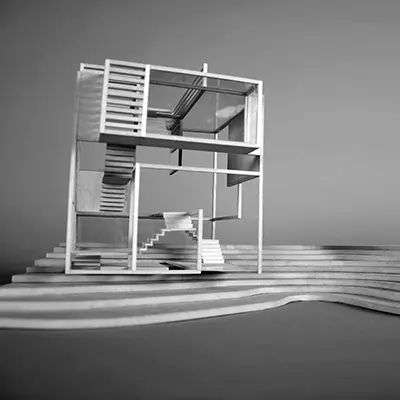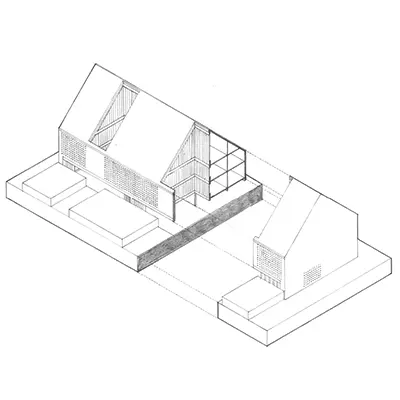Architecture (BA)
Architecture (BA)
The Bachelor of Arts in Architecture (BA) program provides a robust foundation in architectural design with skills transferrable to related disciplines. The ability to define a problem, work through design iterations, and refine evaluative criteria are some of the transferrable skills that will prepare students for multidisciplinary and interdisciplinary design practices within and beyond architecture.
With an emphasis on building strong portfolios, students have the option to pursue graduate school or employment in architecture or related fields upon graduation. Curricular flexibility enables students to select courses that best prepares them for their individualized goals. The BA program is institutionally accredited by the WASC Senior College and University Commission (WSCUC). The program is not accredited by NAAB and may not be accepted as meeting architectural licensure requirements in many U.S. states. In the State of California, the BA degree offers a modified path to architectural licensure.
Bachelor of Arts in Architectural Design (BA-ARH) Degree
Available Online & On Campus
Core Classes




Unit Requirements
| Major Coursework | Units |
|---|---|
| Core | 18 |
| Sophomore Portfolio | 3 |
| Senior Portfolio | 3 |
| Major | 39 |
| Liberal Arts | 42 |
| Elective | 9 |
| Total | 114 |
Degree Requirements
BA ARCHITECTURAL DESIGN DEGREE REQUIREMENTS
- Minimum 2.0 GPA
- Minimum grade of C- in all core courses, major courses, and the following Liberal Arts courses:
LA 219 History of the Built Environment 1: Ancient to Gothic
LA 249 History of the Built Environment 2: Renaissance to 1900
LA 255 College Math
LA 271 College Algebra with Geometry
LA 292 Programming & Culture
LA 293 Mathematics for Architects
LA 296 Applied Physics
LA 319 History of the Built Environment 3: 1900 to Present
LA 359 Urban Sociology
LA 429 Architecture Theory
LA 485 Tell your Story: Personal Statement, Portfolio, Resume
And the following general education requirements:
3 History of the Built Environment courses
1 Written Communications: Research and Analysis course
1 Art & Design Communication course
1 Ecological Systems course
1 Fundamental Math course
1 Applied Math course
1 Advanced Math course
1 Applied Physics course
1 Cultural Influences & Human Behavior course
1 Historical Awareness course
1 Architecture Employment Communications & Practices course
After above general education requirements are met, take Liberal Arts electives as needed to fulfill the Liberal Arts unit requirement.
Additional Information

Program Learning Outcomes
Undergraduate students will meet the following student performance criteria:
Conceptual Thinking and Process
- Communicate architectural concept verbally and in writing
- Articulate and extend architectural concept through diagrams
- Develop a rigorous material logic for model-making to test ideas
- Produce diagrams indicating critical analyses of relevant precedent buildings or the built environment recognizing the significance to the discipline of architecture
- Develop a design identity which synthesizes critical thought, architectural intent, and urban design strategies by developing decision-making criteria substantiated by research
Fundamental Design & Drawing and Making
- Develop criteria to generate and evaluate an architectural order and formal language
- Develop architectural proposals sensitive to the site context in scale and use based on research
- Produce architectural drawings with appropriate drawing conventions to convey spatial qualities and design intent
- Convey materiality in design projects based on an understanding of construction material properties
- Construct drawings and models with a high level of craft and attention to detail
Presentation Skills
- Clearly explain and defend design projects in verbal presentations
- Create presentation boards, slides, and/or printed materials which exhibit logical sequencing and a hierarchy of information
- Develop effective visual communication strategies to convey information that build towards an argument
Leadership and Community
- Demonstrate a commitment to community building and social equity through programming and organization of an architectural project
- Demonstrate sensitivity to diverse viewpoints of user groups in the design of a building
- Engage a collaborative process in the development of a design, with a range of design and engineering disciplines
Integrated Design
- Conduct a user & programmatic analysis
- Communicate analyses of the urban and environmental conditions of a site with clear graphic devices
- Integrate sustainable and energy-conscious strategies into the design of a building
- Communicate analyses of environmental performance systems of the design with clear graphic devices
- Develop an energy-conscious strategy for the design of building envelope systems and material selection
- Integrate structural systems into the design of a building
- Produce technical documentation describing the integration of architecture and building systems
- Accommodate accessibility and life safety requirements in the design of a building
Academy of Art University Learning Outcomes
Graduates of the Academy of Art University will demonstrate the ability to:
- Produce a body of work suitable for seeking professional opportunities in their chosen field of art and design.
- Solve creative problems within their field of art and design, including research and synthesis of technical, aesthetic, and conceptual knowledge.
- Communicate their ideas professionally and connect with their intended audience using visual, oral, and written presentation skillsrelevant to their field.
- Execute technical, aesthetic, and conceptual decisions based on an understanding of art and design principles.
- Use professional terminology to evaluate their work and work in the field.
- Recognize the influence of major cultural and aesthetic trends, both historical and contemporary, on art and design products.
- Learn the professional skills and behaviors necessary to compete in the global marketplace for art and design
- Engage with a variety of communities beyond the classroom through internship opportunities, study abroad programs, athletics, student interest clubs, and participation in collaborative, civic, and pro bono projects.
*Semester plans are subject to change at any time. Semester breakdowns displayed are suggested and additional options are available to help customize your educational experience. Speak to an admissions or student services representative for more information. Please see our catalog for more details at: https://catalog.academyart.edu